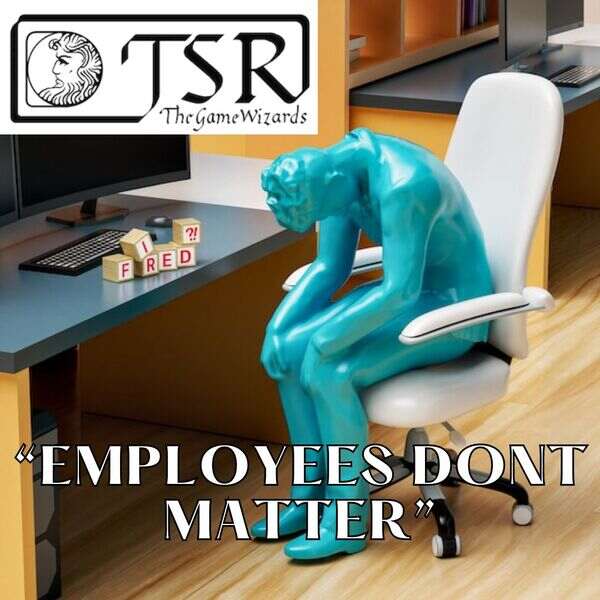In the cutthroat realm of corporate decisions and profit margins, the cautionary tale of TSR, vividly depicted in Ben Rigg’s “Slaying the Dragon,” serves as a stark reminder of the profound impact choices can have on staff culture and loyalty. In this blog post, we’ll delve into the benefits of prioritizing employee well-being, drawing inspiration from TSR’s misstep, and explore three practical methods to implement now, emphasizing the importance of learning from history.
The TSR Example: A Warning on Neglecting Employee Well Being
In his book, Rigg masterfully recounts TSR’s ill-fated decision to remove writers’ royalties. Prior to this decision the staff writers, who were being poorly paid, could make significant money through royalty agreements assigned to their work. Of course, this encouraged the team to go above and beyond with the products they were creating. It was a win-win for the company and the employees.
Unfortunately, the leadership stopped seeing it that way. Instead, the Blumes (in their role as the executive), considered the royalty program as giving money away. No consideration was given to the well-being of the staff. In fact Ben states in his book that leadership of TSR considered their staff to be interchangeable and disposable. Ultimately, the move not only shattered the financial stability of those who contributed significantly to the company’s success but also eroded the very fabric of the staff culture that had propelled TSR to greatness. Loyalty evaporated, morale plummeted, and the once-thriving workplace crumbled under the weight of shortsighted decisions.
For more information on the rise and fall of TSR you can check out my recent post on the subject.
Benefits of Employee Well Being, Illustrated by TSR’s Downfall
To many looking after your employees and the benefits it brings them and the company seems obvious. However, the demands of business and the stress of sitting at the top can often obfuscate these advantages. Below, I describe three benefits that come with putting your employee well-being at the top of your leadership agenda.
- Enhanced Productivity: TSR’s hasty removal of writers’ royalties in “Slaying the Dragon” stands as a poignant testament to the link between employee well-being and productivity. When staff feel valued and adequately compensated, their dedication soars, driving productivity and fostering a positive work environment. Recognizing and compensating employees for their contributions is not just a moral obligation—it’s a strategic investment in the company’s success.
- Improved Employee Retention: The TSR saga serves as a vivid illustration of the repercussions of neglecting employee well-being. The sudden removal of royalties triggered many creatives to leave the business, resulting in the loss of invaluable talent and institutional knowledge. Investing in employee satisfaction and loyalty is a proactive measure to safeguard against the high costs of turnover, recruitment, and training.
- Positive Company Culture: The demise of TSR in “Slaying the Dragon” underscores the corrosive impact of a toxic culture. Neglecting the well-being of employees can lead to an environment where creativity stifles, collaboration withers, and collective morale crumbles. Prioritizing employee well-being, on the other hand, nurtures a positive culture where collaboration thrives, and individuals feel supported and valued.

Easy Methods to Demonstrate Care, In Light of TSR’s Mistakes
- Regular Check-Ins: Learning from TSR’s lack of communication with its writers, implement regular check-ins to ensure open lines of communication. These meetings provide a platform for employees to voice concerns, share successes, and discuss professional development. Thus, demonstrating a commitment to their well-being and fostering a sense of belonging.
- Flexible Work Arrangements: TSR’s failure to adapt to changing circumstances serves as a stark lesson in the importance of flexibility. Offering options such as remote work, flexible hours, or compressed workweeks shows a willingness to accommodate diverse employee needs. Ultimately, contributing to a healthier work-life balance and greater overall satisfaction.
- Recognition and Rewards: In the aftermath of TSR’s decision, it’s evident that neglecting to appreciate employee efforts can be catastrophic. Implementing recognition programs, providing bonuses, and organizing team-building activities are tangible ways to express gratitude. Which fosters a positive workplace culture encouraging loyalty and dedication.

Final Thoughts
The TSR example, vividly portrayed in “Slaying the Dragon,” serves as a haunting reminder of the consequences of neglecting employee well-being. By prioritizing open communication, flexibility, and recognition, you can build a resilient and positive workplace culture. This not only prevents the pitfalls faced by TSR, i.e. a loss of corporate knowledge and expertise, but also positions your organization for sustained success. In the end, the lessons from history underscore that the foundation of any thriving business is the well being and loyalty of its staff.

